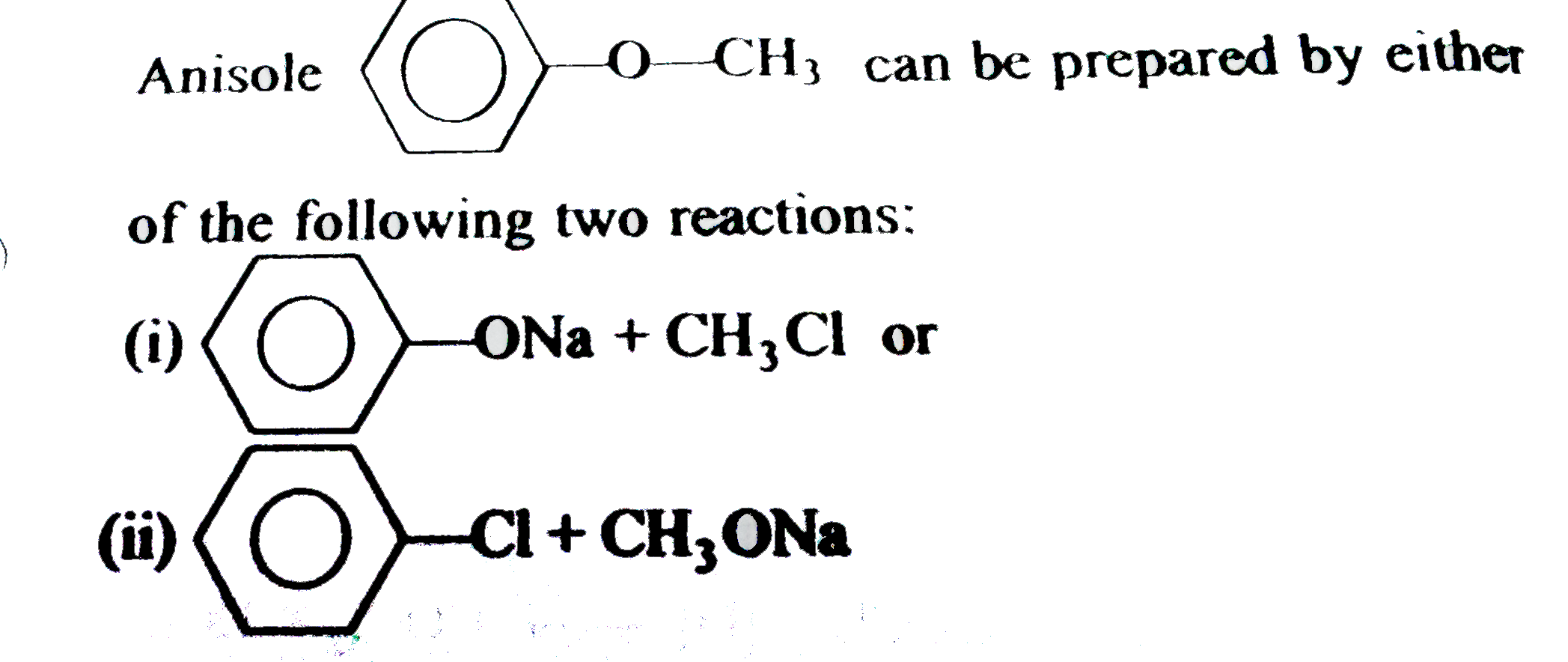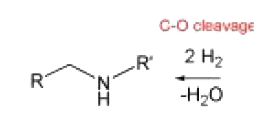Assertion Diphenyl ether (Ph-O-Ph) is very less reactive in acid catalyzed hydrolysis to phenol.
Reason Oxygen is in resonance on bot side with phenyl ring.
The correct Answer is:a
Step by step video, text & image solution for Assertion Diphenyl ether (Ph-O-Ph) is very less reactive in acid catalyzed hydrolysis to phenol. Reason Oxygen is in resonance on bot side with phenyl ring. by Chemistry experts to help you in doubts & scoring excellent marks in Class 12 exams.
Updated on:21/07/2023Topper's Solved these Questions
Similar Questions
Explain the following :
(a) Carbon tetrachloride is used as fire extinguisher.
(b) Use of chloroform as anaesthetic is decreasing.
(C) Chloroform is kept with a little ethyl alcohol in a dark brown coloured bottle.
(d) Iodoform gives precipitate with AgNO3 on heating while chloroform does not.
(E) Alkyl iodides become darken on standing in presence of light.
(f) A small amount of Nal or KI catalyses the hydrolysis of R-CI or the reaction,
R−CI+R'ONa→R−O−R'+NaCI
(g) while preparing alkyl halides from alkanes ,dry gaseous hydrohalgen acids are used instead of their aqueous solutions.
(h) Hydrogen atom of chloroform is definitely acidic in nature.
(i) Vinyl halide is less reactive while allyl halide is more reactive than alkyl halides. or
Vinyl chloride does not gives SN reaction but allyl chloride gives.
(j) Why is free radical halogenation of alkanes is seldom used for laboratory preparation of alkyl halides ? Under what condition good yields of monosubstituted chloride can be obtained ?
(K) What effect should the following resonance of vinyl chloride have on its dipole moment?
H2C−δ+CH−δ−CI⇔H2δ−C−CH=δ+CI
(I) 2-Chloro-3-methylbutane on treatment with alcoholic potash gives2- methylbut-2-ene as the major product.
(m) Compare the rates of (i) SN1and(iii)SN2 reactions of allyl chloride and n-propyl chloride.
(N) When CH3CH=CHCH2CI reacts with alcoholic potassium cyanide, a mixture of isomeric product is obtained.
(O) the formation of the products giving the structures of the intermediates.

(q) Arrange C6H5CH2CH2CI, C6H5CHCICH3 and C6H5CH=CHCI in the order of their decreasing activities with alcoholic silver nitrate.
(r) Arrange CH3CH2Br,C6H5 and C6H5CH2Br in order of their decreasing activities with KCN.
(s) Chlorobenzene is less reactive as compared to ethyl chloride.
View SolutionAssertion (A) : C2H5OHis a weaker base than phenol but is a stronger nucleophile than phenol .
Reason (R ) : In phenol the lone pair of electrons on oxygen is withdrawn towards the ring due to resonance .
View Solution
Knowledge Check
Assertion : Phenol is acidic in nature.
Reason : Hydrid for phenate ion is less resonance stabilised than hybrid for phenol.AIf both assertion and reason are correct and reason is correct explanation for assertion.BIf both assertion and reason are correct but reason is not correct explanation for assertion.CIf assertion is correct but reason is incorrect.DIf assertion and reason both are incorrect.Assertion : C2H5OH is a weaker base than phenol but is a stronger nucleophile than phenol.
Reason : In phenol the lone pair of electrons on oxygen is withdrawn towards the ring due to resonance.ABoth assertion and reason are correct statements, and reason is the correct explanation of the assertionBBoth assertion and reason are correct statements, but reason is not the correct explanation of the assertionCAssertion is correct, but reason is wrong statement.DAssertion is wrong, but reason is correct statement.Assertion (A) : Ethers are classified on the basis of alkyl groups attached to the oxygen atom.
Reason (R) : The presence of −OH group in phenols deactivates the aromatic ring towards electrophilic substitution.ABoth Assertion (A) and Reason (R) are correct statements, and Reason (R) is the correct explanation of the Assertion (A).BBoth Assertion (A) and Reason (R) are correct statements, but Reason (R) is not the correct explanationof the Assertion (A).CAssertion (A) is correct, but Reason (R) is incorrect statement.DAssertion (A) is incorrect, but Reason (R) is correct statement.
Assertion : C2H5OH is a weaker acid than phenol but is a stronger nucleophile than phenol.
Reason : In phenol, lone pair of electrons on oxygen is directed towards the ring due to resonance.
View SolutionRead the passage given below and answer the following questions:
Reduction of carboxylic acids and their derivatives plays an important role in organic synthesis, in both laboratory and industrial processes. Traditionally, the reduction is performed using stochiometric amounts of hydride reagents, generating stochiometric amounts of waste. A much more attractive, atom-economical approach is a catalytic reaction using H2, however, hydrogenation of carboxylic acid derivatives under mild conditions is a very challenging task, with amides presenting the highest challenge among all classes of carbonyl compounds. Very few examples of the important hydrogenation of amides to amines, in which the C-O bond is cleaved with the liberation of water (Scheme 1), were reported. C-O cleavage of amides can also be affected with silanes as reducing agents.

We have now prepared the new, dearomatized, bipyridine-based pincer complex 3, catalyst 3(Here refered as Cat. 3). Remarkably, it efficiently catalyzes the selective hydrogenation of amides to form amines and alcohols (eq 1). The reaction proceeds under mild pressure and neutral conditions, with no additives being required. Since the reaction proceeds well under anhydrous conditions, hydrolytic cleavage of the amide is not involved in this process.

(Balaraman, E., Gnanaprakasam, B., Shimon, L. J., & Milstein, D. (2010). Direct hydrogenation of amides to alcohols and amines under mild conditions. Journal of the American Chemical Society, 132(47), 16756-16758.)
In the following questions, a statement of assertion followed by a statement of reason is given. Choose the correct answer out of the following choices on the basis of the above passage.
Assertion: N-methyl ethanamide on reaction with catalyst 3 will yield ethanol and methanamine.
Reason: Use of Catalyst 3 brings about cleavage of C-N bond of amides
View SolutionAssertion: Anisole undergoes eletctrophilic substitution at o−and p−positions.
Reason: Anisole is less reactive than phenol towards electrohphilic substitution reactions.
View SolutionRead the passage given below and answer the following questions:
Aryl halides are extremely less reactive towards nucleophilic substitution reactions due to the following reasons:
(i) In haloarenes, the electron pairs on halogen atom are in conjugation with u-electrons of the ring.
(ii) In haloalkane, the carbon atom attached to halogen is sp3 hybridised while in case of haloarene, the carbon atom attached to halogen is sp2 -hybridised.
In case of haloarenes/ the phenyl cation formed as a result of self-ionisation will not be stabilised by resonance.
A primary alkyl halide would prefer to undergo _______
View SolutionRead the passage given below and answer the following questions:
Aryl halides are extremely less reactive towards nucleophilic substitution reactions due to the following reasons:
(i) In haloarenes, the electron pairs on halogen atom are in conjugation with u-electrons of the ring.
(ii) In haloalkane, the carbon atom attached to halogen is sp3 hybridised while in case of haloarene, the carbon atom attached to halogen is sp2 -hybridised.
In case of haloarenes/ the phenyl cation formed as a result of self-ionisation will not be stabilised by resonance.
What is A' in the following reaction ?

View Solution
